English 153 Essay: Suffering and Renewal in House Made of Dawn
VerifiedAdded on 2022/12/09
|6
|1877
|167
Essay
AI Summary
This essay provides a critical analysis of N. Scott Momaday's novel "House Made of Dawn," focusing on the central theme of how suffering can lead to renewal, as highlighted by T.S. Eliot's poem "Little Gidding." The essay explores the character development of Abel, the protagonist, and how he navigates pain, alienation, and cultural identity. It examines Abel's initial recklessness, detachment, and struggles with the dominant American culture and language, which contribute to his suffering. The analysis delves into how these experiences, including the loss of his grandfather, ultimately lead to his reconnection with his native roots and a sense of renewal. The essay also considers the novel's significance within American Native literature and its contribution to the broader themes of cultural identity and the transformative power of adversity.
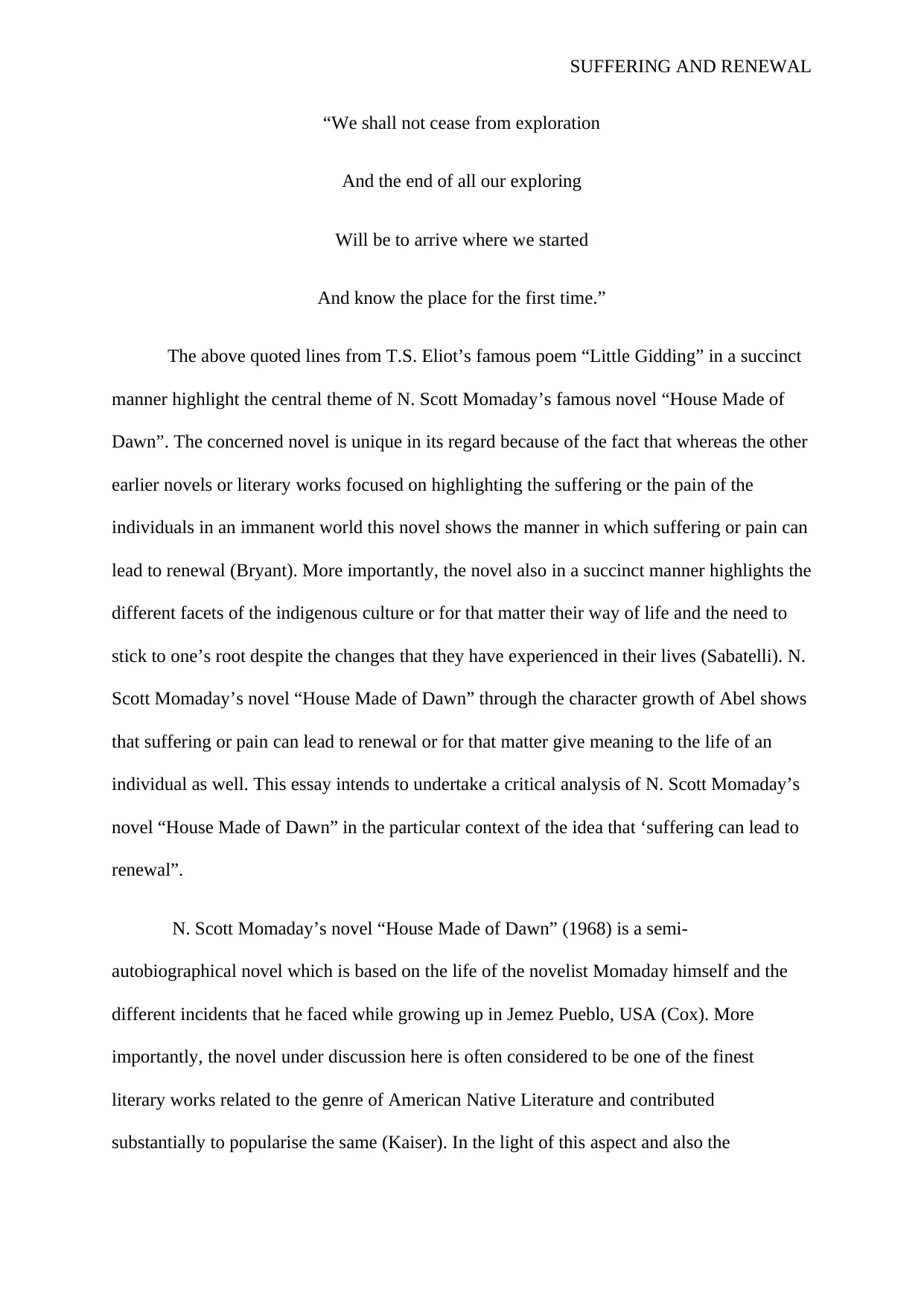
SUFFERING AND RENEWAL
“We shall not cease from exploration
And the end of all our exploring
Will be to arrive where we started
And know the place for the first time.”
The above quoted lines from T.S. Eliot’s famous poem “Little Gidding” in a succinct
manner highlight the central theme of N. Scott Momaday’s famous novel “House Made of
Dawn”. The concerned novel is unique in its regard because of the fact that whereas the other
earlier novels or literary works focused on highlighting the suffering or the pain of the
individuals in an immanent world this novel shows the manner in which suffering or pain can
lead to renewal (Bryant). More importantly, the novel also in a succinct manner highlights the
different facets of the indigenous culture or for that matter their way of life and the need to
stick to one’s root despite the changes that they have experienced in their lives (Sabatelli). N.
Scott Momaday’s novel “House Made of Dawn” through the character growth of Abel shows
that suffering or pain can lead to renewal or for that matter give meaning to the life of an
individual as well. This essay intends to undertake a critical analysis of N. Scott Momaday’s
novel “House Made of Dawn” in the particular context of the idea that ‘suffering can lead to
renewal”.
N. Scott Momaday’s novel “House Made of Dawn” (1968) is a semi-
autobiographical novel which is based on the life of the novelist Momaday himself and the
different incidents that he faced while growing up in Jemez Pueblo, USA (Cox). More
importantly, the novel under discussion here is often considered to be one of the finest
literary works related to the genre of American Native Literature and contributed
substantially to popularise the same (Kaiser). In the light of this aspect and also the
“We shall not cease from exploration
And the end of all our exploring
Will be to arrive where we started
And know the place for the first time.”
The above quoted lines from T.S. Eliot’s famous poem “Little Gidding” in a succinct
manner highlight the central theme of N. Scott Momaday’s famous novel “House Made of
Dawn”. The concerned novel is unique in its regard because of the fact that whereas the other
earlier novels or literary works focused on highlighting the suffering or the pain of the
individuals in an immanent world this novel shows the manner in which suffering or pain can
lead to renewal (Bryant). More importantly, the novel also in a succinct manner highlights the
different facets of the indigenous culture or for that matter their way of life and the need to
stick to one’s root despite the changes that they have experienced in their lives (Sabatelli). N.
Scott Momaday’s novel “House Made of Dawn” through the character growth of Abel shows
that suffering or pain can lead to renewal or for that matter give meaning to the life of an
individual as well. This essay intends to undertake a critical analysis of N. Scott Momaday’s
novel “House Made of Dawn” in the particular context of the idea that ‘suffering can lead to
renewal”.
N. Scott Momaday’s novel “House Made of Dawn” (1968) is a semi-
autobiographical novel which is based on the life of the novelist Momaday himself and the
different incidents that he faced while growing up in Jemez Pueblo, USA (Cox). More
importantly, the novel under discussion here is often considered to be one of the finest
literary works related to the genre of American Native Literature and contributed
substantially to popularise the same (Kaiser). In the light of this aspect and also the
Paraphrase This Document
Need a fresh take? Get an instant paraphrase of this document with our AI Paraphraser
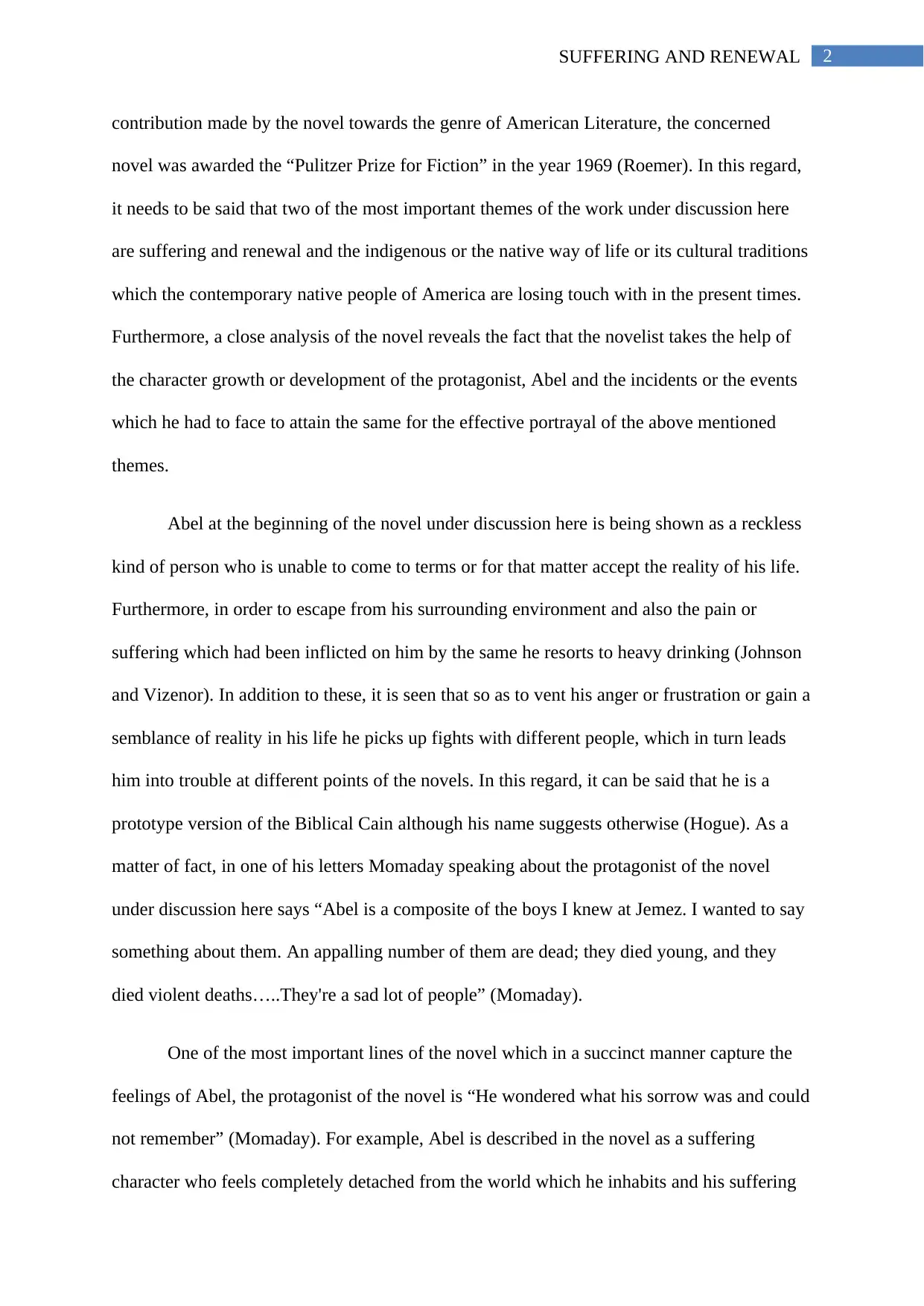
2SUFFERING AND RENEWAL
contribution made by the novel towards the genre of American Literature, the concerned
novel was awarded the “Pulitzer Prize for Fiction” in the year 1969 (Roemer). In this regard,
it needs to be said that two of the most important themes of the work under discussion here
are suffering and renewal and the indigenous or the native way of life or its cultural traditions
which the contemporary native people of America are losing touch with in the present times.
Furthermore, a close analysis of the novel reveals the fact that the novelist takes the help of
the character growth or development of the protagonist, Abel and the incidents or the events
which he had to face to attain the same for the effective portrayal of the above mentioned
themes.
Abel at the beginning of the novel under discussion here is being shown as a reckless
kind of person who is unable to come to terms or for that matter accept the reality of his life.
Furthermore, in order to escape from his surrounding environment and also the pain or
suffering which had been inflicted on him by the same he resorts to heavy drinking (Johnson
and Vizenor). In addition to these, it is seen that so as to vent his anger or frustration or gain a
semblance of reality in his life he picks up fights with different people, which in turn leads
him into trouble at different points of the novels. In this regard, it can be said that he is a
prototype version of the Biblical Cain although his name suggests otherwise (Hogue). As a
matter of fact, in one of his letters Momaday speaking about the protagonist of the novel
under discussion here says “Abel is a composite of the boys I knew at Jemez. I wanted to say
something about them. An appalling number of them are dead; they died young, and they
died violent deaths…..They're a sad lot of people” (Momaday).
One of the most important lines of the novel which in a succinct manner capture the
feelings of Abel, the protagonist of the novel is “He wondered what his sorrow was and could
not remember” (Momaday). For example, Abel is described in the novel as a suffering
character who feels completely detached from the world which he inhabits and his suffering
contribution made by the novel towards the genre of American Literature, the concerned
novel was awarded the “Pulitzer Prize for Fiction” in the year 1969 (Roemer). In this regard,
it needs to be said that two of the most important themes of the work under discussion here
are suffering and renewal and the indigenous or the native way of life or its cultural traditions
which the contemporary native people of America are losing touch with in the present times.
Furthermore, a close analysis of the novel reveals the fact that the novelist takes the help of
the character growth or development of the protagonist, Abel and the incidents or the events
which he had to face to attain the same for the effective portrayal of the above mentioned
themes.
Abel at the beginning of the novel under discussion here is being shown as a reckless
kind of person who is unable to come to terms or for that matter accept the reality of his life.
Furthermore, in order to escape from his surrounding environment and also the pain or
suffering which had been inflicted on him by the same he resorts to heavy drinking (Johnson
and Vizenor). In addition to these, it is seen that so as to vent his anger or frustration or gain a
semblance of reality in his life he picks up fights with different people, which in turn leads
him into trouble at different points of the novels. In this regard, it can be said that he is a
prototype version of the Biblical Cain although his name suggests otherwise (Hogue). As a
matter of fact, in one of his letters Momaday speaking about the protagonist of the novel
under discussion here says “Abel is a composite of the boys I knew at Jemez. I wanted to say
something about them. An appalling number of them are dead; they died young, and they
died violent deaths…..They're a sad lot of people” (Momaday).
One of the most important lines of the novel which in a succinct manner capture the
feelings of Abel, the protagonist of the novel is “He wondered what his sorrow was and could
not remember” (Momaday). For example, Abel is described in the novel as a suffering
character who feels completely detached from the world which he inhabits and his suffering
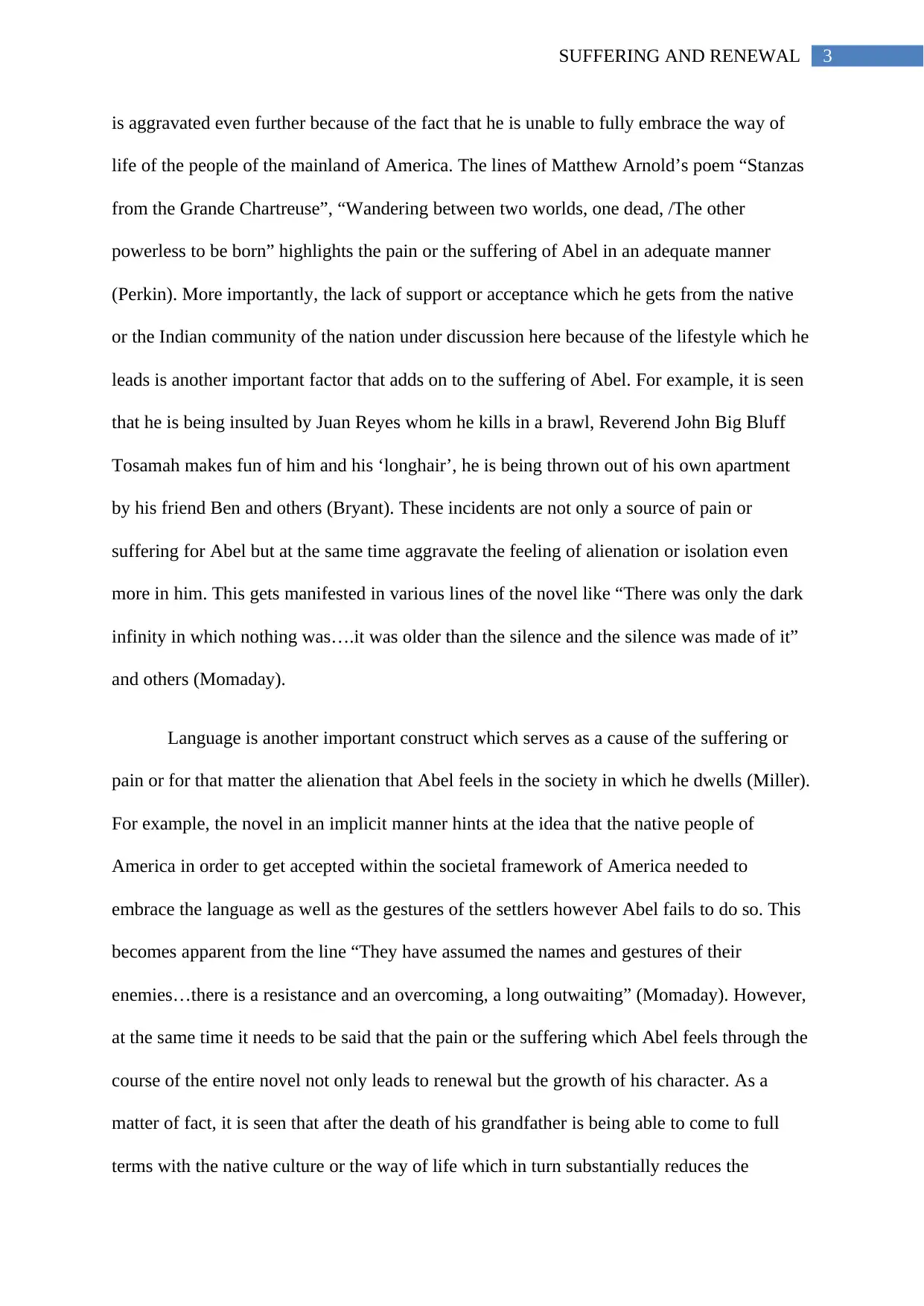
3SUFFERING AND RENEWAL
is aggravated even further because of the fact that he is unable to fully embrace the way of
life of the people of the mainland of America. The lines of Matthew Arnold’s poem “Stanzas
from the Grande Chartreuse”, “Wandering between two worlds, one dead, /The other
powerless to be born” highlights the pain or the suffering of Abel in an adequate manner
(Perkin). More importantly, the lack of support or acceptance which he gets from the native
or the Indian community of the nation under discussion here because of the lifestyle which he
leads is another important factor that adds on to the suffering of Abel. For example, it is seen
that he is being insulted by Juan Reyes whom he kills in a brawl, Reverend John Big Bluff
Tosamah makes fun of him and his ‘longhair’, he is being thrown out of his own apartment
by his friend Ben and others (Bryant). These incidents are not only a source of pain or
suffering for Abel but at the same time aggravate the feeling of alienation or isolation even
more in him. This gets manifested in various lines of the novel like “There was only the dark
infinity in which nothing was….it was older than the silence and the silence was made of it”
and others (Momaday).
Language is another important construct which serves as a cause of the suffering or
pain or for that matter the alienation that Abel feels in the society in which he dwells (Miller).
For example, the novel in an implicit manner hints at the idea that the native people of
America in order to get accepted within the societal framework of America needed to
embrace the language as well as the gestures of the settlers however Abel fails to do so. This
becomes apparent from the line “They have assumed the names and gestures of their
enemies…there is a resistance and an overcoming, a long outwaiting” (Momaday). However,
at the same time it needs to be said that the pain or the suffering which Abel feels through the
course of the entire novel not only leads to renewal but the growth of his character. As a
matter of fact, it is seen that after the death of his grandfather is being able to come to full
terms with the native culture or the way of life which in turn substantially reduces the
is aggravated even further because of the fact that he is unable to fully embrace the way of
life of the people of the mainland of America. The lines of Matthew Arnold’s poem “Stanzas
from the Grande Chartreuse”, “Wandering between two worlds, one dead, /The other
powerless to be born” highlights the pain or the suffering of Abel in an adequate manner
(Perkin). More importantly, the lack of support or acceptance which he gets from the native
or the Indian community of the nation under discussion here because of the lifestyle which he
leads is another important factor that adds on to the suffering of Abel. For example, it is seen
that he is being insulted by Juan Reyes whom he kills in a brawl, Reverend John Big Bluff
Tosamah makes fun of him and his ‘longhair’, he is being thrown out of his own apartment
by his friend Ben and others (Bryant). These incidents are not only a source of pain or
suffering for Abel but at the same time aggravate the feeling of alienation or isolation even
more in him. This gets manifested in various lines of the novel like “There was only the dark
infinity in which nothing was….it was older than the silence and the silence was made of it”
and others (Momaday).
Language is another important construct which serves as a cause of the suffering or
pain or for that matter the alienation that Abel feels in the society in which he dwells (Miller).
For example, the novel in an implicit manner hints at the idea that the native people of
America in order to get accepted within the societal framework of America needed to
embrace the language as well as the gestures of the settlers however Abel fails to do so. This
becomes apparent from the line “They have assumed the names and gestures of their
enemies…there is a resistance and an overcoming, a long outwaiting” (Momaday). However,
at the same time it needs to be said that the pain or the suffering which Abel feels through the
course of the entire novel not only leads to renewal but the growth of his character. As a
matter of fact, it is seen that after the death of his grandfather is being able to come to full
terms with the native culture or the way of life which in turn substantially reduces the
⊘ This is a preview!⊘
Do you want full access?
Subscribe today to unlock all pages.

Trusted by 1+ million students worldwide
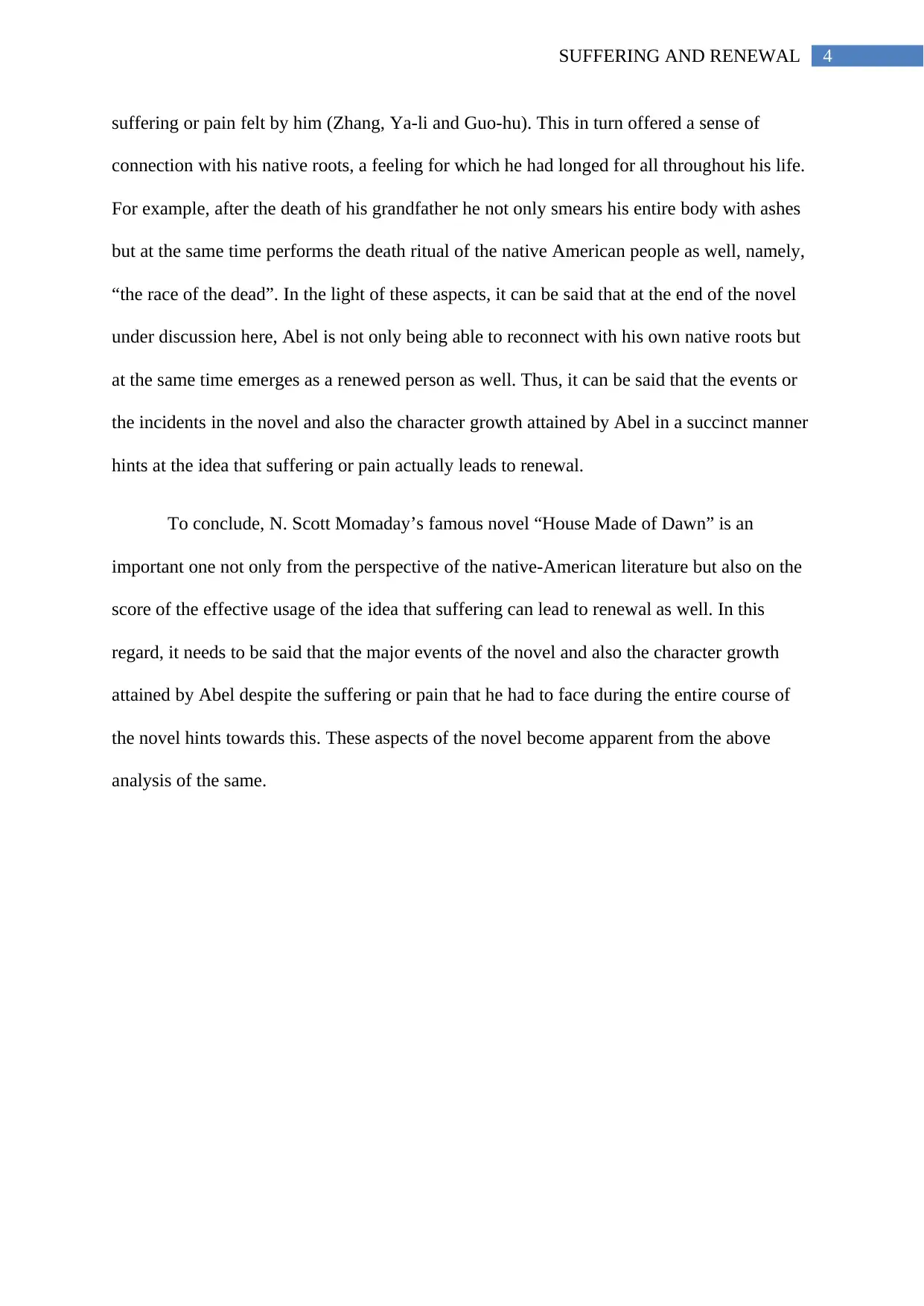
4SUFFERING AND RENEWAL
suffering or pain felt by him (Zhang, Ya-li and Guo-hu). This in turn offered a sense of
connection with his native roots, a feeling for which he had longed for all throughout his life.
For example, after the death of his grandfather he not only smears his entire body with ashes
but at the same time performs the death ritual of the native American people as well, namely,
“the race of the dead”. In the light of these aspects, it can be said that at the end of the novel
under discussion here, Abel is not only being able to reconnect with his own native roots but
at the same time emerges as a renewed person as well. Thus, it can be said that the events or
the incidents in the novel and also the character growth attained by Abel in a succinct manner
hints at the idea that suffering or pain actually leads to renewal.
To conclude, N. Scott Momaday’s famous novel “House Made of Dawn” is an
important one not only from the perspective of the native-American literature but also on the
score of the effective usage of the idea that suffering can lead to renewal as well. In this
regard, it needs to be said that the major events of the novel and also the character growth
attained by Abel despite the suffering or pain that he had to face during the entire course of
the novel hints towards this. These aspects of the novel become apparent from the above
analysis of the same.
suffering or pain felt by him (Zhang, Ya-li and Guo-hu). This in turn offered a sense of
connection with his native roots, a feeling for which he had longed for all throughout his life.
For example, after the death of his grandfather he not only smears his entire body with ashes
but at the same time performs the death ritual of the native American people as well, namely,
“the race of the dead”. In the light of these aspects, it can be said that at the end of the novel
under discussion here, Abel is not only being able to reconnect with his own native roots but
at the same time emerges as a renewed person as well. Thus, it can be said that the events or
the incidents in the novel and also the character growth attained by Abel in a succinct manner
hints at the idea that suffering or pain actually leads to renewal.
To conclude, N. Scott Momaday’s famous novel “House Made of Dawn” is an
important one not only from the perspective of the native-American literature but also on the
score of the effective usage of the idea that suffering can lead to renewal as well. In this
regard, it needs to be said that the major events of the novel and also the character growth
attained by Abel despite the suffering or pain that he had to face during the entire course of
the novel hints towards this. These aspects of the novel become apparent from the above
analysis of the same.
Paraphrase This Document
Need a fresh take? Get an instant paraphrase of this document with our AI Paraphraser
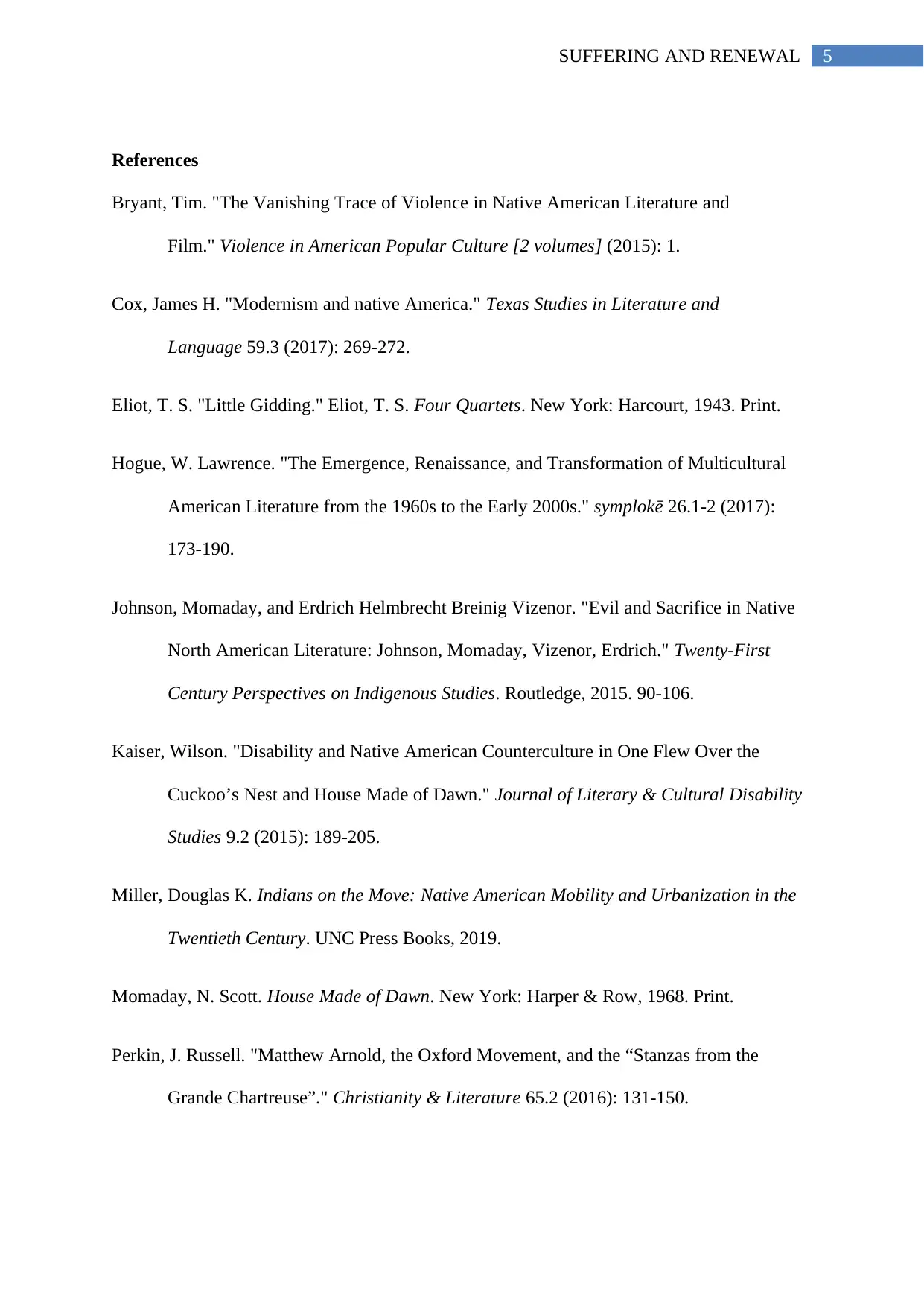
5SUFFERING AND RENEWAL
References
Bryant, Tim. "The Vanishing Trace of Violence in Native American Literature and
Film." Violence in American Popular Culture [2 volumes] (2015): 1.
Cox, James H. "Modernism and native America." Texas Studies in Literature and
Language 59.3 (2017): 269-272.
Eliot, T. S. "Little Gidding." Eliot, T. S. Four Quartets. New York: Harcourt, 1943. Print.
Hogue, W. Lawrence. "The Emergence, Renaissance, and Transformation of Multicultural
American Literature from the 1960s to the Early 2000s." symplokē 26.1-2 (2017):
173-190.
Johnson, Momaday, and Erdrich Helmbrecht Breinig Vizenor. "Evil and Sacrifice in Native
North American Literature: Johnson, Momaday, Vizenor, Erdrich." Twenty-First
Century Perspectives on Indigenous Studies. Routledge, 2015. 90-106.
Kaiser, Wilson. "Disability and Native American Counterculture in One Flew Over the
Cuckoo’s Nest and House Made of Dawn." Journal of Literary & Cultural Disability
Studies 9.2 (2015): 189-205.
Miller, Douglas K. Indians on the Move: Native American Mobility and Urbanization in the
Twentieth Century. UNC Press Books, 2019.
Momaday, N. Scott. House Made of Dawn. New York: Harper & Row, 1968. Print.
Perkin, J. Russell. "Matthew Arnold, the Oxford Movement, and the “Stanzas from the
Grande Chartreuse”." Christianity & Literature 65.2 (2016): 131-150.
References
Bryant, Tim. "The Vanishing Trace of Violence in Native American Literature and
Film." Violence in American Popular Culture [2 volumes] (2015): 1.
Cox, James H. "Modernism and native America." Texas Studies in Literature and
Language 59.3 (2017): 269-272.
Eliot, T. S. "Little Gidding." Eliot, T. S. Four Quartets. New York: Harcourt, 1943. Print.
Hogue, W. Lawrence. "The Emergence, Renaissance, and Transformation of Multicultural
American Literature from the 1960s to the Early 2000s." symplokē 26.1-2 (2017):
173-190.
Johnson, Momaday, and Erdrich Helmbrecht Breinig Vizenor. "Evil and Sacrifice in Native
North American Literature: Johnson, Momaday, Vizenor, Erdrich." Twenty-First
Century Perspectives on Indigenous Studies. Routledge, 2015. 90-106.
Kaiser, Wilson. "Disability and Native American Counterculture in One Flew Over the
Cuckoo’s Nest and House Made of Dawn." Journal of Literary & Cultural Disability
Studies 9.2 (2015): 189-205.
Miller, Douglas K. Indians on the Move: Native American Mobility and Urbanization in the
Twentieth Century. UNC Press Books, 2019.
Momaday, N. Scott. House Made of Dawn. New York: Harper & Row, 1968. Print.
Perkin, J. Russell. "Matthew Arnold, the Oxford Movement, and the “Stanzas from the
Grande Chartreuse”." Christianity & Literature 65.2 (2016): 131-150.
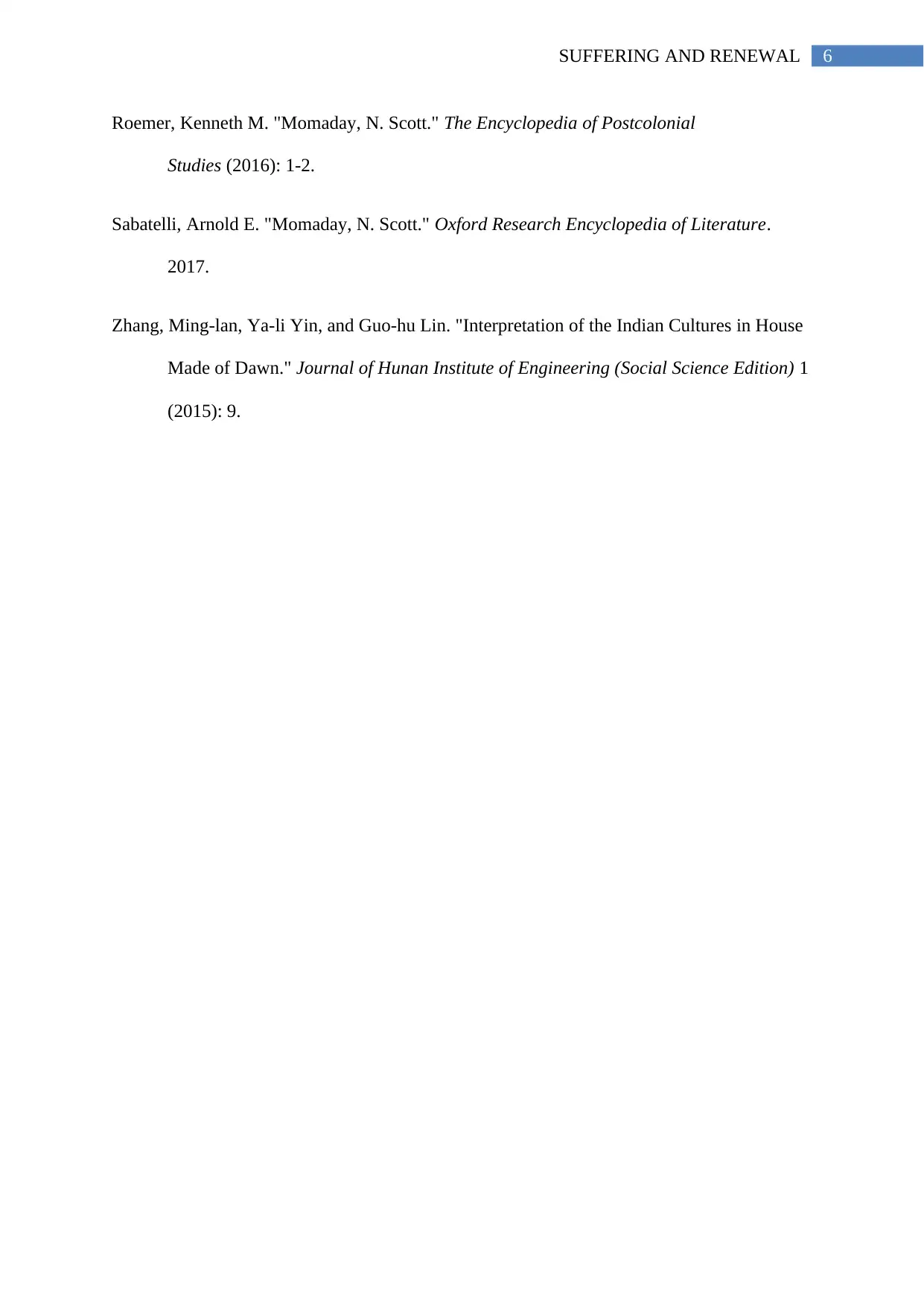
6SUFFERING AND RENEWAL
Roemer, Kenneth M. "Momaday, N. Scott." The Encyclopedia of Postcolonial
Studies (2016): 1-2.
Sabatelli, Arnold E. "Momaday, N. Scott." Oxford Research Encyclopedia of Literature.
2017.
Zhang, Ming-lan, Ya-li Yin, and Guo-hu Lin. "Interpretation of the Indian Cultures in House
Made of Dawn." Journal of Hunan Institute of Engineering (Social Science Edition) 1
(2015): 9.
Roemer, Kenneth M. "Momaday, N. Scott." The Encyclopedia of Postcolonial
Studies (2016): 1-2.
Sabatelli, Arnold E. "Momaday, N. Scott." Oxford Research Encyclopedia of Literature.
2017.
Zhang, Ming-lan, Ya-li Yin, and Guo-hu Lin. "Interpretation of the Indian Cultures in House
Made of Dawn." Journal of Hunan Institute of Engineering (Social Science Edition) 1
(2015): 9.
⊘ This is a preview!⊘
Do you want full access?
Subscribe today to unlock all pages.

Trusted by 1+ million students worldwide
1 out of 6
Your All-in-One AI-Powered Toolkit for Academic Success.
+13062052269
info@desklib.com
Available 24*7 on WhatsApp / Email
![[object Object]](/_next/static/media/star-bottom.7253800d.svg)
Unlock your academic potential
Copyright © 2020–2025 A2Z Services. All Rights Reserved. Developed and managed by ZUCOL.


